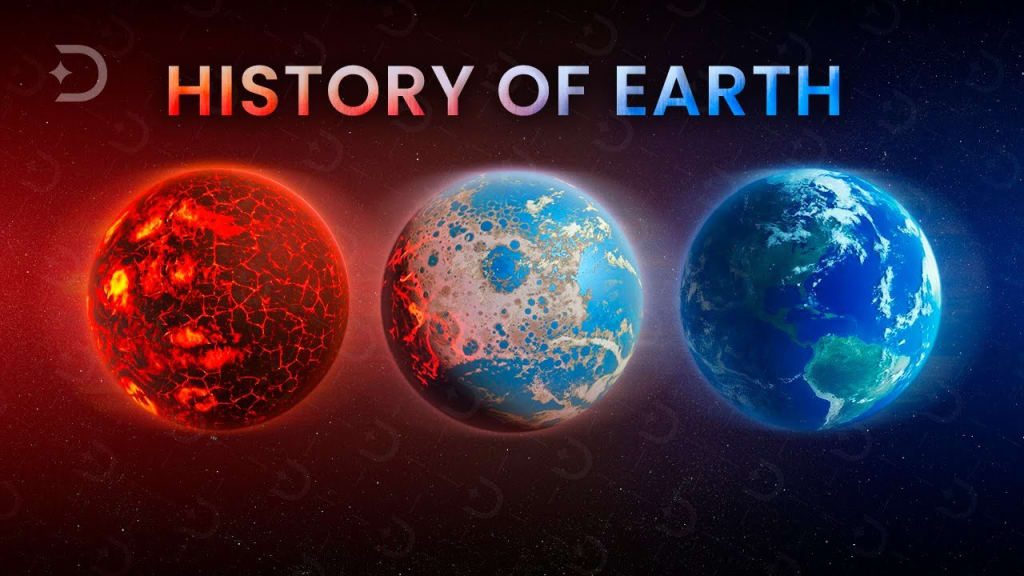Earth Evolution in 10 Minutes
History of Earth

Earth Evolution in 10 Minutes
In the past few billion years, Earth has endured asteroid impacts, collisions with other planets, and multiple freezing events. It's a wonder that our blue Homeworld has survived at all. To take a whirlwind tour of our planet's history, let's start at the very beginning, about four and a half billion years ago. Our solar system began to form from a dense cloud of interstellar gas and dust. This cloud collapsed into a swirling disc of matter that grew hotter and hotter until hydrogen fused into helium, giving birth to our Sun and our baby Earth.
After the birth of our star, the matter on the outer edges of the swirling disc began to clump together. These clumps eventually formed the planets and moons in our solar system. As they accumulated more matter, they grew larger and more spherical. In the cooler regions of the solar system, the clumps were mostly made of ice, liquids, and gases. Closer to the Sun, the rocky material formed the inner planets, including Mars and Earth.
During its early years, Earth was extremely active volcanically, releasing gases such as hydrogen sulfide, methane, and carbon dioxide. These gases formed the planet's first atmosphere. Earth was also bombarded by large asteroids and comets, but the most significant event was the collision with Thea, a planet the size of Mars. This collision threw matter into Earth's orbit, which eventually bound together to form the Moon.
At this time, Earth had no oceans, and water existed only as gas. However, about 3.8 billion years ago, the planet cooled enough for water to condense and become liquid. The very first primitive ocean covered the young Earth, transforming it into a water world. Water, H2O, is a vital ingredient for the creation of life, and approximately 3.7 billion years ago, life appeared in the form of microscopic organisms.
It took nearly a billion years for some of these organisms to change the course of the world. Earth's first continents emerged from the ancient ocean, and scientists refer to them as cratons. As more land rose from the ocean, the first supercontinent, called Vaalbara, formed. Vaalbara relatively small, estimated to be smaller than the continent of Australia.
Around 2.4 billion years ago, cyanobacteria evolved as Earth's first photosynthesizers. This development significantly increased the production of oxygen, making Earth's atmosphere more hospitable. With the rise of oxygen, Earth's atmosphere experienced a reduction in carbon dioxide levels, resulting in a frigid climate and the planet's first ice age.
While the atmosphere and climate continued to change, the continents were also in motion. They broke apart and reassembled into the supercontinent Rodinia, one of the largest supercontinents to have existed. During this time, life on Earth became more complex, leading to the Cambrian explosion approximately 540 to 485 million years ago. During this period, animals with hard body parts, such as shells or spines, emerged, including the famous trilobites.
Around 440 million years ago, the climate shifted dramatically, causing a change in ocean temperatures. Earth witnessed the Ordovician-Silurian extinction, a mass extinction event that wiped out a majority of life on the planet. However, many of these organisms laid the foundation for the ecosystems present on Earth today.
Between 420 and 350 million years ago, the first trees appeared on Earth, and animals began to make their way to land. By 250 million years ago, our planet was covered by the massive supercontinent known as Pangea. Unfortunately, this period also saw the most significant mass extinction event in Earth's history, known as the Great Dying. Approximately 90 percent of all species were wiped out due to high levels of greenhouse gases and accelerated global warming. However, this mass extinction event created opportunities for the next wave of animal evolution.
Between 240 and 230 million years ago, dinosaurs emerged and ruled the land for the next 150 million years. Giant creatures like the Argentinosaurus, the largest land animal ever, and fearsome predators like the T-Rex dominated the Earth. During this time, Pangea started breaking up, eventually forming the continents we recognize today.
So, that's a brief glimpse into the incredible history of our planet, but there is still much more to explore!
About the Creator
Celine Dy👸🏻💜
Sharing inspiration 😊
Finding Joy💕
Sending Love🫶






Comments
There are no comments for this story
Be the first to respond and start the conversation.